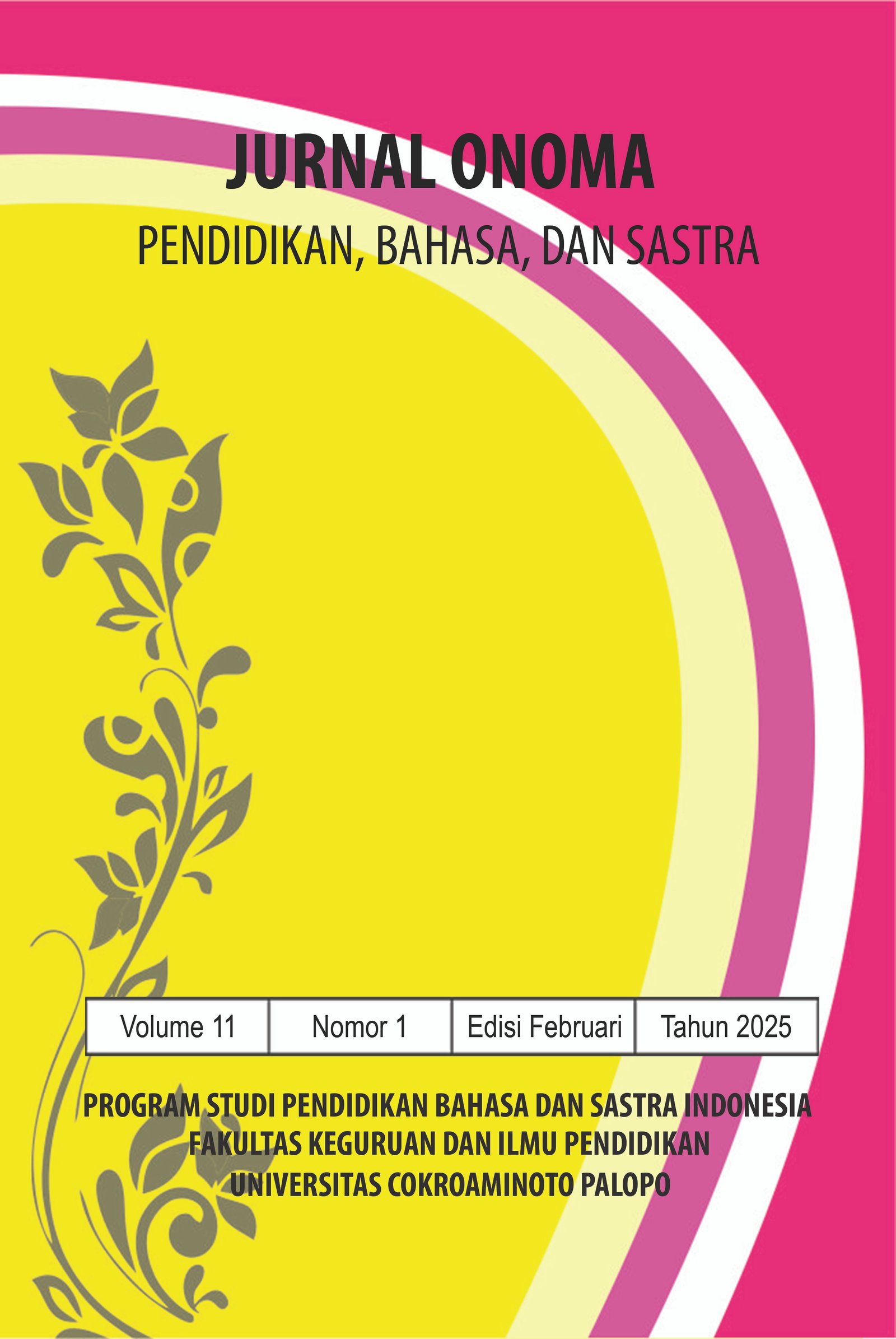Analisis Ketakterjemahan Takarir pada Soundtrack di Film “La Reine de Neige” (Frozen) Hasil Terjemahan Otomatis Youtube di Channel DISNEYFR
https://doi.org/10.30605/onoma.v11i1.5256
Keywords:
Ketakterjemahan, soundtrack, budaya, linguistikAbstract
Penelitian ini bertujuan untuk mendeskripsikan dan menjelaskan faktor-faktor ketakterjemahan yang terjadi pada takarir soundtrack film La Reine de Neige yang diterjemahkan secara otomatis oleh YouTube ke dalam bahasa Indonesia. Ketakterjemahan mencakup aspek linguistik dan budaya, yang masing-masing dikaji menggunakan teori Vinay dan Darbelnet serta Newmark. Dari 235 bait lagu, ditemukan 73 data yang kurang sesuai, terdiri atas 10 data ketakterjemahan linguistik (4,26%) dan 6 data ketakterjemahan budaya (2,55%). Hasil penelitian menunjukkan bahwa penerjemahan unsur budaya relatif baik, namun penerjemahan linguistik memiliki kelemahan dalam struktur dan kealamian bahasa. Faktor utama penyebab ketakterjemahan adalah kurangnya penyesuaian dalam penerjemahan otomatis serta tidak adanya pengecekan ulang. Penelitian ini menyarankan perlu adanya analisis ulang pada teks takarir untuk meningkatkan keterbacaan dan akurasi, sekaligus membuka peluang penelitian lanjutan terkait penerjemahan otomatis. Penelitian ini memberikan kontribusi penting bagi pengembangan kajian penerjemahan audiovisual, khususnya dalam konteks bahasa Indonesia.
Downloads
References
Audiovisual translation: Subtitling. (2007). Translation Practices Explained. St. Jerome Publishing. Routledge. Retrieved from https://doi.org/10.4324/9781315759602
Baharruddin. (2023, April 30). The negotiating strategy in translating the untranslatable concepts in Al-Qur'an. Parole: Journal of Linguistics and Education, 13(1), 70–80. Retrieved from http://ejournal.undip.ac.id/index.php/parole
Catford, J. C. (1965). A Linguistic Theory of Translation. Oxford University Press.
Cui, J. (2012, April). Untranslatability and the method of compensation. Academy Publication, 2(4), 826–830. https://doi.org/10.4304/tpls.2.4.826-830 DOI: https://doi.org/10.4304/tpls.2.4.826-830
DisneyFr. (2013, December 23). Libérée, délivrée (La Reine des Neiges) [Video]. DisneyFr. Retrieved October 2024, from https://youtu.be/wQP9XZc2Y_c
Gambier, H., & Gottlieb, H. (2001). Screen translations: The dialects of subtitling. John Benjamins Publishing.
Gottlieb, H. (2018). The politics of audiovisual translation (1st ed.). Routledge. DOI: https://doi.org/10.4324/9781315621289-21
Indarta, A. (2010, April 29). Lokalisasi dan penerjemah. Ade Indarta. Retrieved December 25, 2024, from https://adeindarta.com/2010/04/29/lokalisasi-dan-penerjemah/comment-page-1/
Karunaratha, J. A. M. B. (2015). Translating the untranslatable: An analysis on translating culture-specific references in translating a script for dubbing purpose. International Journal of Multidisciplinary Studies (IJMS, 2(II). Retrieved from https://www.bing.com DOI: https://doi.org/10.4038/ijms.v2i2.70
Kramsch, C. (1988). Language and culture. Oxford University Press.
Miles, M. B., & Huberman, A. M. (1984). Qualitative data analysis: A sourcebook of new methods. Sage Publication.
Neuman, W. L. (2014). Social research methods: Qualitative and quantitative approaches. Pearson.
Newmark, P. (1988). A textbook of translation. Prentice Hall.
Ngambelumbun, M. M. (n.d.). Ketakterjemahan dalam penerjemahan. Academia.edu, 8(1), 15–18. Retrieved from https://www.academia.edu/83750208/Ketakterjemahan_Dalam_Penerjemahan_Untranslatability_in_Translation
Sudaryono. (2018). Metode penelitian: Pendekatan kuantitatif dan kualitatif. Bandung: Remaja Rosdakarya.
Venuti, L. (1995). The translator's invisibility: A history of translation. Routledge.
Zahara, R., & Z. (2024). Analisis kualitas terjemahan otomatis subtitle pada channel YouTube (Indo4arab Khalid Nahdi). Jurnal Pendidikan Agama Islam dan Filsafat, 1. Retrieved from https://doi.org/10.61132/akhlak.v1i4.448 DOI: https://doi.org/10.61132/akhlak.v1i4.448
Downloads
Published
How to Cite
License
In submitting the manuscript to the journal, the authors certify that:
- They are authorized by their co-authors to enter into these arrangements.
- The work described has not been formally published before, except in the form of an abstract or as part of a published lecture, review, thesis, or overlay journal.
- That it is not under consideration for publication elsewhere,
- That its publication has been approved by all the author(s) and by the responsible authorities – tacitly or explicitly – of the institutes where the work has been carried out.
- They secure the right to reproduce any material that has already been published or copyrighted elsewhere.
- They agree to the following license and copyright agreement.
License and Copyright Agreement
Authors who publish with Onoma Journal: Education, Languages??, and Literature agree to the following terms:
- Authors retain copyright and grant the journal right of first publication with the work simultaneously licensed under Creative Commons Attribution License (CC BY 4.0) that allows others to share the work with an acknowledgment of the work's authorship and initial publication in this journal.
- Authors are able to enter into separate, additional contractual arrangements for the non-exclusive distribution of the journal's published version of the work (e.g., post it to an institutional repository or publish it in a book), with an acknowledgment of its initial publication in this journal.
- Authors are permitted and encouraged to post their work online (e.g., in institutional repositories or on their website) prior to and during the submission process, as it can lead to productive exchanges, as well as earlier and greater citation of published work.

















